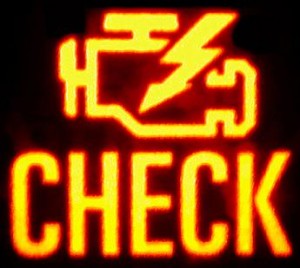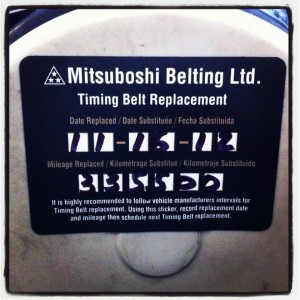We proudly warranty all work done by Good Carma Automotive for 12 months or 12,000 miles, whichever comes first, so you can rest assured that your vehicle will be fixed right and guaranteed! Unfortunately we cannot warranty customer provided parts, but in some cases such as batteries we can offer extended warranties longer than one year!
5 Automobile Maintenance Myths
 We have worked on tons and tons of vehicles (literally), at various places (some great, some not so much) throughout our careers, and it’s safe to say that we’ve see a lot of crazy stuff. We’ve pulled all kinds of critters out of all kinds of places in all kinds of cars. We’ve seen cars do things that defy reason, physics, and even the laws of nature. We have even seen how cars can be used to store some extremely interesting items. Oh, the stories we could tell! Many may not even be appropriate for this blog! but out of all of the crazy and unbelievable things we’ve experienced working in the auto repair industry, nothing comes close to the myths and tall tales we’ve encountered in this business. And being your local shop, we feel it is our SACRED and SOLEMN duty to dispel these silly notions and far-fetched fantasies about automotive maintenance and repair.
We have worked on tons and tons of vehicles (literally), at various places (some great, some not so much) throughout our careers, and it’s safe to say that we’ve see a lot of crazy stuff. We’ve pulled all kinds of critters out of all kinds of places in all kinds of cars. We’ve seen cars do things that defy reason, physics, and even the laws of nature. We have even seen how cars can be used to store some extremely interesting items. Oh, the stories we could tell! Many may not even be appropriate for this blog! but out of all of the crazy and unbelievable things we’ve experienced working in the auto repair industry, nothing comes close to the myths and tall tales we’ve encountered in this business. And being your local shop, we feel it is our SACRED and SOLEMN duty to dispel these silly notions and far-fetched fantasies about automotive maintenance and repair.
Personally, we only think car repair is fun to do when your car needs it. After all, we are all about Good Carma. We’ve seen some shady scams and stories out there, but fear not! Class is in session. The Good Carma Profs are here to drop knowledge. Here are 5 common myths about automotive repair and maintenance that you can now stop believing. Get yer learn on!
1. Fuel Injector Cleaning Shenanigans – We hear this one all the time. You take your car in for an oil change or minor maintenance and learn that your injectors need to be cleaned. Your car seems to run just fine but for some reason, your fuel injectors are clogged and the end of the world is nigh! In 1995, the EPA mandated that detergents needed to be included in fuels to prevent engine buildup (some interesting reading on this here). While it is conceivable that injectors could clog up, it’s highly unlikely to occur with today’s modern fuels especially with low mileage cars. Most of the time, these “injector cleanings” are simply dumping a bottle of fuel treatment into your gas tank. So be aware and if your car isn’t running terribly, your injectors are probably working just fine.
2. Coolant Flush Hijinks – With today’s modern vehicles, these flushes are not needed too often. Your best bet is to follow your vehicles owner’s manual. Flushes or coolant fluid replacements are usually recommended by these manuals around every 5 years or 60,000 miles or so.
3. The Ol’ Chassis Lube-Up Rigmarole – Again, with most modern vehicles, this is an unnecessary procedure. Most components on the chassis that need lubrication are lubed and sealed already. We’ve seen this service written up on quotes all the time and “performed” many times unnecessarily.
4. Brake Fluid/Power Steering Fluid Service Scam – Like the coolant flush scam, we’ve seen this one a lot too. Shops and oil-change places will tell you that your power steering fluid or brake fluid is dirty and that you need a “Fluid Service”. In these closed systems, it’s best to wait until the recommendation of your owners manual says to do it. Again, these fluids are usually required to be replaced around 50,000 or 60,000 miles. So it’s important to make sure you know when your maintenance intervals are (especially for things like the timing belt, etc.). These “services” are usually just a vacuuming out of the reservoir and refilling it up.
5. Tire Inflation Discrepancy – This isn’t a scam but according to our research, it is common enough of a mistake to be classified as a “myth”. When inflating your tires, do not use the pressure specification on the sidewall of the tire. The correct tire pressure that you should maintain will be printed on a sticker on the driver side door jamb of the car. If the sticker has been removed or damaged, check your owner’s manual or look it up online.
We’d love to know your thoughts on this post. If you have any questions or myth ideas or comments or anything else you’d like to say, let us know! Email us at goodcarmauto@gmail.com or message us on Facebook here at our page! Give us a “like” and say hi! See you at the next post.
Dodging the Lemon: Buying a Used Car

How to avoid a lemon when buying a used car.
Buying a used car, financially speaking, can be a good way to go. Of course, purchasing the WRONG car can be an automotive repair nightmare down the road. You want your “new” ride to get you where you’re going and stay out of the shop, and you want to make sure that what you’re purchasing is a good deal? Well, look at the luck on you. This article was written for you!
Research.
This is key. Know ahead of time what kind of vehicle you want. SUV or car? Minivan or roadster? Also, research the reliability and resale value of the different brands. Talk to your friends and family. Chat up your mechanic. Get an idea before you go shopping. Our Resources Page has a lot of good links for that, including a link to the J.D. Power site which contains a trove of information, reviews and reports about every type of car. Find out the value of the car by using a site like Kelly Blue Book or NADA. Armed with this information, you can now go out and find the car you’re looking for at the price you want.

Pre-Buy Research.
OK. You’ve shopped around all over town, you savvy bargain hunter you, and you’ve found the make and model of your desired car for the price you want to pay… but is it THE ONE? It’s sleek, it’s shiny, and it’s clean… but is it your new road trip companion or a hunk of immobile metal waiting to sit on the side of a road somewhere? Get the VIN. This 17 character number is the Vehicle’s unique Identification Number and can usually be found on the dash under the windshield or on the driver’s door or door frame. Using a website like Experian’s AutoCheck, this series of numbers and letters can be used to research the car’s history. This can help you determine if the vehicle was severely damaged or has a salvage title. Also, ask the previous owner what kind of work has been done to the car. Note the mileage. Anything major recommended work coming up such as a timing belt?
Get a Buyer’s Check.
Next stop is to a mechanic you trust (…ahem) to get a Buyer’s Check. This is a meticulous top-to-bottom, front-to-back, inwards-to-outwards inspection of the car. We keep an eye out for signs that the car was not properly maintained, that the car has been wrecked, or for any upcoming (or existing) repair issues. It’s thorough and we do it really CHEAP. The car may need work and we can quote a cost of repair which you can use in your purchase negotiation. We love talking about cars and we can share our experiences and opinions to help you make an informed decision. So remember, friends: Before You Buy, Bring it By! <– sorry, I had to. It just came to me.
We want to be the shop you trust and we want you to be happy and safe out there on the roads. It’s Good Carma, after all. Spread it around!
Good Carma Gift Certificates
 Need Gift Ideas?
Need Gift Ideas?
Give the gift of a great running car. We just printed off a batch of Good Carma Automotive gift certificates just in time for the holidays. Purchase them for any amount and give them away (or gift yourself for a later repair). Have a family member that needs some auto work done? Get them a Gift Certificate today. And because our prices are extremely competitive with any other shop in town, your money goes farther. You get ASE Certified repairs on your vehicle for way less than the other guys and you keep it local.
Stop by or give us a call today to get your Gift Certificate.
3400 Rogge Lane ATX 78723
512-928-0605
The Dreaded Check Engine Light

OK, first off… your car is probably not going to blow up or anything, but this could be a sign of something serious. It could also be something very, very minor. Besides not being able to pass your State Inspection, it could indicate that your car is not running at its full potential/efficiency/gas-mileage/etc. The only way to tell, is to just get it checked. I once read somewhere that it was estimated that 10% of the cars on the road in the US had a check engine light (Malfunction Indicator Lamp or MIL) on (not to be confused with the “Maintenance Required” light). Pretending it’s not there will not make the problem go away and in some cases, ignoring certain issues can lead to bigger problems down the road. So don’t worry. Find out what it is and go from there. *NOTE* A flashing check engine light indicates an active misfire which can cause serious problems if you continue to drive your car. If your check engine light is flashing, get it to your auto repair technician as soon as possible.
Get The Code.
If your Check Engine Light appears on your dashboard, find out more. Your car’s computer will store a code(s) that can be read by a specialized scanner to indicate what the malfunction is. Of course we can do this for you and we do it for free, but you can also go to numerous other places like auto parts stores or oil change places, etc. But be careful, they may charge a fairly expensive “diagnostic fee” for this service. If they have the tool, they can scan it and get the codes for you. Be sure to get the actual codes and not just a diagnosis or an explanation of the problem (codes for a 1996 car or newer look like P0420 or P0300). The code can be very specific and if the codes are somehow cleared off of your vehicle’s computer, you can still provide that information to your automotive technician which can lead to an accurate diagnosis.
Don’t Ignore It
Even if your car seems to be running just fine, get your vehicle scanned. Again, while it may be something minor, it is possible that ignoring the issue could cause more damage if left unattended. For example, a faulty spark plug can cause the MIL to light up indicating a misfiring cylinder. Because the spark plug is not igniting the fuel mixture properly, excess fuel is forced through the catalytic converter through exhaust which can greatly reduce the life of this part. Sparks plugs are relatively cheap to replace but a catalytic converter installation can be very pricey. So it’s a good idea to catch a diagnosis early. And again, Good Carma Automotive does these checks for free and we don’t charge diagnostic fees. So if your check engine light (MIL) is on, swing on by and have us scan it for you. You’ll know what your up against and can keep your car healthy and happy.
Save Your Car! Timing Belt Replacements and You!

OK, the title may be a tad bit melodramatic, but replacing your timing belt on time (pun intended) could be the difference between life and death… for your car. And here’s why!
In your engine, the timing belt (and/or chain) runs on pulleys connected to the camshafts and crankshaft of your motor, tying them all together. It keeps everything synchronized and turning in the correct time by controlling the opening and closing of valves in your motor. If the position of the timing belt is off by even one tooth, your car’s performance can be seriously affected causing a drop in power or a rough running engine.
Timing Belt. Fail.
A timing belt breaking on you can be much worse. In many engines (called interference motors) if the timing belt fails, the valves and pistons can collide causing serious damage to the valves. Repairing this can be extremely costly, so it is important to follow your vehicle manufacturer’s guidelines on replacing your timing belt. Not sure about yours? Don’t have your Owner’s Manual? Check this out: Gates has this handy guide with the recommended mileage to replace the timing belt (or as the guide calls it, a cam belt). This guide also shows you if your car has an interference motor. Note: if your car doesn’t appear on this list, it probably has a timing chain which requires replacement less often.

Is your car in need of a timing belt replacement?
If it is, of course we can help you with that. We love doing timing belt jobs. And we do them thoroughly. We also replace all of the other components underneath the timing cover that may need replacement in the future (water pump, cam and crank seals, tensioners, balance shaft belts, etc.). That way, we do the job once and don’t have to go back in until the next scheduled replacement. Wherever you end up getting the service done, make sure that these parts are replaced as well. A lot of the cost of doing a timing belt job comes from labor costs, so you might as well replace everything you can behind the timing cover while you are already there.
The cost of replacing your timing belt can vary depending on the type of vehicle and motor. We are extremely competitive with our pricing here at Good Carma Auto. Generally, these types of jobs (including all components) on a typical domestic or Japanese car can average between $800 – $1200; again, depending on the vehicle. We usually can get the same job done for around $400 – $600. Give us a call and we can look it all up for you and provide you with a detailed quote.
As with all aspects of maintaining your vehicle, make sure you keep an eye on your mileage and follow the recommended maintenance guidelines. If you are unsure, call us or stop by. We can look it up for you. This will keep your car functioning efficiently and prolong the life of your vehicle. You and your car will be much happier. That’s kind of what we’re all about.
Learn more about timing belts and interderence motors and more:
http://en.wikipedia.org/wiki/Timing_belt
Winterize Your Car

Hey folks! As cold weather approaches us here in the Austin area, there are several things you should be thinking about in terms of automotive maintenance to prepare yourself for winter. Although our winters are not particularly extreme in Texas, a 30 degree temperature change can affect your car or truck in many ways.
Tires. A 30 degree temperature change can lower your tire pressure by up to 15 psi. The air in your tires actually shrinks against the cold air, so it is therefore necessary to check your tire pressure regularly as the temperature changes. Another important thing to remember is that your front tires will unvaryingly wear down faster than your rear tires because the turning motion of steering wears the edges of the front tires. Rear tires hold up better as they really only wear out in the middle. That’s why it’s important for everyone to rotate their tires regularly. This extends the life of your tires and keeps you safer out on the road. This should be generally be done about every other oil change, which brings us to our next point…
Changing your oil. Many people underestimate the importance of such basic maintenance as changing your oil, but there is nothing more singularly important for the life of your engine than changing your oil regularly. This becomes more important the older your car gets and the more miles it accumulates. The slightest oil leak could lead to an automotive disaster. It is also important to make sure to use the recommended weight for your car.
Battery service. When temperatures get colder, batteries tend to die. It’s important to check your connections, clean corrosion off of terminals and contact points, and test the battery. Cold weather puts a strain on your battery so make sure it’s up to the task for the upcoming months.
Maintain your windshield. In the winter we often have significantly more precipitation, so new wiper blades are always good to check or replace as winter approaches. Also, make sure to use windshield washer fluid rated for low temperatures. You don’t want that freezing up in the reservoir, causing significant damage.
Check your belts and hoses. Consider cold weather’s affect on rubber. If you’ve ever paid attention to a rubber object left out in the cold, you know that the cold will significantly dry out and crack rubber materials as they age. For this reason, it’s important to have your belts and hoses checked before the winter arrives because they will dry out significantly in the colder weather.
Fluids. Our final maintenance concern for the winter. Changing your coolant can be very important for keeping your car cool in the summer, but also for keeping your heater working well for the winter. The engine coolant is actually what creates the heat for your heater and your heater core can get clogged up easily over the summer while it isn’t being used. If you plan on taking any road trips into the rest of the US where they have an actual winter, you should definitely have your car checked out before the trip, and consider more substantial fluid services such as brake, clutch and power steering fluid changes as well. Four wheel drive fluid services can always be a life saver as we rarely get a chance to use them in Texas, and the fluid inside the front differentials are often very dirty and neglected.
Most importantly, always remember that we are happy to check out any problem you have with your car, but are also happy to tell you what basic maintenance your car needs or doesn’t need, and we’re glad to do it for no charge every day of the week! Now that’s Good Carma!

